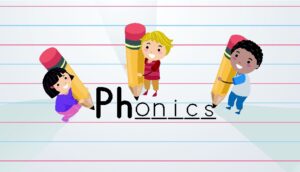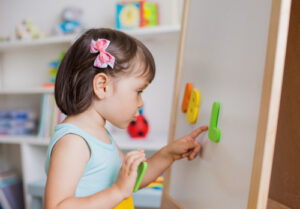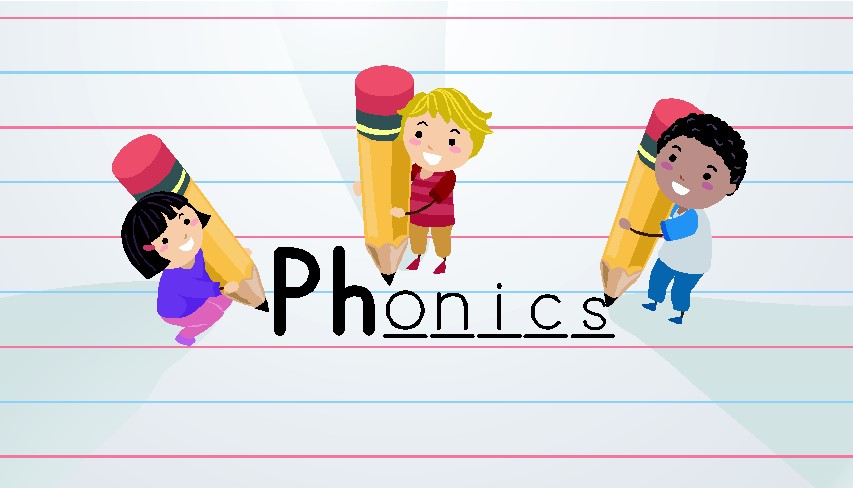Literacy expert Gill Matthews, shares some simple ideas for how to make phonics learning fun and enjoyable. You may find this helpful to share with your pupils’ parents or you can adapt the ideas for your home learning plan.

Phonics is about learning the sounds that individual letters make: singly (a, b, c) or together (th, ck, tch). These sounds are called phonemes. We can put phonemes together to make words (b-i-g; ch-e-ck). One thing to bear in mind is that when you say a phoneme aloud, the sound does not have the ‘uh’ (known as the schwa) on the end. So, say ‘t’ not ‘tuh’. Ask your child to help you to say the phonemes correctly – they will have practised this at school.
Your child will probably be following a phonics programme at school and you may well have been given some materials to use at home. But, there are also many games and activities that you can play together to build up your child’s confidence in using phonics, without it feeling like a lesson. What’s more, all the games and activities can be done without the use of a screen.

I Spy
The Collins Big Cat Phonics for Letters and Sounds books (Lilac to Red A band) have an I-spy feature built in which uses visual support to embed phonic knowledge. You can replicate this at home with the I Spy game. Show how to play the game, choosing the initial sound of the object e.g. ‘I spy with my little eye, something beginning with c.’ then ask your child to have a go. Initially you can use the sound the letter makes, then you can move on to the name of the letter. Later, you can progress to spying something ending with a particular sound, or even identifying the middle sound.
Another version of this game is ‘I hear with my little ear.’ This encourages careful listening – an important skill in phonics as well as in life generally!
Rhyming Words
Again, start by showing how to play the game. Say a simple CVC word (consonant-vowel-consonant) e.g. cat and then produce some rhyming words to match e.g. bat, hat, rat. Encourage your child to join in with some suggestions of their own. Say another word and, this time, just give one rhyming word and then ask your child to join in. The third time, only give the word and encourage your child to produce as many rhyming words as they can. You might want to list the words they give on a board or wall chart, to show just how many words they thought of. Don’t worry if the rhyming words your child gives are nonsense words – it’s hearing the sounds that is important.
Phonics Snap
Make a set of cards, and write an individual letter, or groups of letters, on each card. Make sure that you have at least two of each phoneme. Play snap with your child, encouraging them to say each phoneme as they put their card down and, of course, to shout out ‘Snap!’ if they spot a matching card. You could also use these cards to play a game of
Phonics Pairs: spread the cards out, face down. Take it in turns to turn over a card, saying the phoneme as you do so. The idea is to collect pairs of matching cards – so memory is important here as well as identifying sounds!
Treasure Hunt
Choose a phoneme, say it clearly to your child and ask them to repeat it. Challenge them to find at least three or more things around the house that start with that sound. Again, you could move on to challenging them to find objects that end with that sound.
 ABC
ABC
If you have magnetic letters or letter cards, ask your child to help you to make the alphabet. If you don’t have those materials, write out the alphabet. Play the ABC game where you take it in turns to name something (or someone!) that starts with each letter of the alphabet in turn. If you have any alphabet books, look at them with your child, involving them in identifying the objects shown for each letter.
Grouping
Ask your child to collect together some of their favourite toys and to group them according to initial, or final, sounds. Encourage your child to draw each toy in a group and to label them. You can also play this game with pictures of objects.

Phonics hopscotch
If you have access to an outside space, draw a hopscotch grid in chalk. In each square write a phoneme. These could be individual letters or groups of letters. Challenge your child to hop and jump along the grid, calling out the phonemes as they land. An alternative version is to also number each square, then throw a dice and your child jumps to that square, again saying the phoneme. Develop the game further by challenging them, when they land on the square, to think of as many words as they can that begin with the phoneme.
Out and About Phonics
We may not be getting outside much at the moment but, whether inside or out, take the opportunity to draw attention to letters and sounds – on packages, signs, street names, adverts – anywhere where there is print. Involve your child in real life reading and writing experiences e.g. writing lists, reading and writing text messages and emails to family and friends, reading instructions for making and doing things. Help them to use their phonics knowledge in their spelling.
And finally – be relaxed about these activities. They are supposed to be fun and enjoyable for both of you. Give plenty of encouragement and praise. If your child isn’t interested or isn’t enjoying an activity – move on to something they do like.
Written by Gill Matthews
Gill Matthews is an education consultant specialising in the field of literacy. She runs training courses for teachers and has written a number of children’s books. Gill has written, edited and advised on a range reading schemes, including Collins Big Cat, and a variety of writing programmes.

Collins Big Cat Phonics for Letters and Sounds has 156 fully decodable fiction and non-fiction readers expertly aligned to the Letters and Sounds phases to ensure all pupils move from decoding words to reading fluently and for pleasure.
Find out more here.



